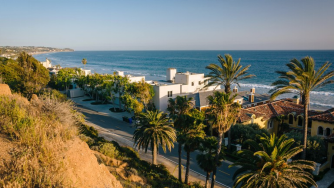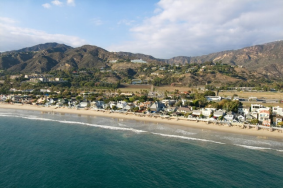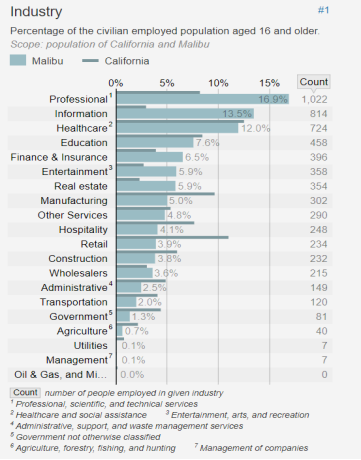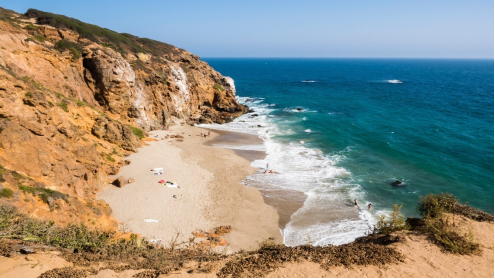Malibu, California 作者: 来源: 发布时间:2021-07-20
I.Population and Area
₋Area
Land: 19.90 sq mi (51.54 km2)
₋Population
Total: 12,645
Density: 595.05/sq mi (229.75/km2)

II.Natural Geography
₋Malibu (/ˈmælɪbuː/) (Spanish: Malibú) is a beach city in western Los Angeles County, California, situated about 30 miles (48 km) west of Downtown Los Angeles. It is known for its Mediterranean climate and its 21-mile (34 km) strip of the Malibu coast, incorporated in 1991 into the City of Malibu. The area is known for being the home of Hollywood movie stars, people in the entertainment industry, and other affluent residents; yet some residents are middle class. Most Malibu residents live within a few hundred yards of Pacific Coast Highway (State Route 1), which traverses the city, with some residents living up to a mile away from the beach up narrow canyons. As of the 2010 census, the city population was 12,645.
₋Nicknamed "the 'Bu" by surfers and locals, beaches along the Malibu coast include Surfrider Beach, Zuma Beach, Malibu Beach, Topanga Beach, Point Dume Beach, County Line, and Dan Blocker Beach. State parks and beaches on the Malibu coast include Malibu Creek State Park, Leo Carrillo State Beach and Park, Point Mugu State Park, and Robert H. Meyer Memorial State Beach, with individual beaches: El Pescador, La Piedra and El Matador. The many parks within the Santa Monica Mountains National Recreation Area lie along the ridges above the city along with local parks that include Malibu Bluffs Park (formerly Malibu Bluffs State Park), Trancas Canyon Park, Las Flores Creek Park, and Legacy Park.
₋Signs around the city proclaim "21 miles of scenic beauty", referring to the incorporated city limits. The city updated the signs in 2017 from the historical 27-mile (43 km) length of the Malibu coast spanning from Tuna Canyon on the southeast to Point Mugu in Ventura County on the northwest. For many residents of the unincorporated canyon areas, Malibu has the closest commercial centers and they are included in the Malibu ZIP Codes. The city is bounded by Topanga on the east, the Santa Monica Mountains (Agoura Hills, Calabasas, and Woodland Hills) to the north, the Pacific Ocean to the south, and Solromar in Ventura County to the west.

III.GDP
₋The average salary in Malibu, CA is $73k. Trends in wages increased by 0.9 percent in Q1 2020. The cost of living in Malibu, CA is 180 percent higher than the national average. The most popular occupations in Malibu, CA are Executive Assistant, Mechanical Engineer, and Research Scientist which pay between $41k and $141k per year. The most popular employers in Malibu, CA are HRL Laboratories, Pepperdine University, and Dun & Bradstreet Corp.
₋Website: https://www.payscale.com/research/US/Location=Malibu-CA/Salary
IV.Industrial Characteristics

₋Website: https://statisticalatlas.com/place/California/Malibu/Industries
V.Attractions
1.Point Dume

₋Point Dume is a promontory on the coast of Malibu, California that juts out into the Pacific Ocean. The point, a long bluff, forms the northern end of the Santa Monica Bay. Point Dume Natural Area affords a vista of the Palos Verdes Peninsula and Santa Catalina Island. Zuma Beach lies to its immediate northwest.
₋Point Dume was named by George Vancouver in 1793 in honor of Padre Francisco Dumetz of Mission San Buenaventura. The name was misspelled on Vancouver's map as "Dume" and was never corrected. On a plat map of the Rancho Topanga Malibu Sequit finally confirmed to new owner Matthew Keller in August 1870, the point is marked on the map as "Point Zuma or Duma". In the early 1980s, real estate development interests began pronouncing the name "du-MAY" and spelling it "Dumé"; this did not catch on. In the mid-1930s, the 900-ton steam-schooner California, of the California Whaling Company, would anchor in Paradise Cove about a mile offshore, near Point Dume, and process whales caught by her two "killer boats", the Hawk and Port Saunders. She spent about four months there each winter (December–April), mostly flensing gray whales on their annual migration from Alaska to Baja California and back. Emerson Gaze, a reporter who spent a day with the fleet, said they had caught over fifty whales up to late January 1936, nearly all gray (with the exception of a few humpback and sperm whales). Nial O’Malley Keyes, in his book Blubber Ship, reported large numbers of whales were caught within a mile of Malibu (in or before 1934), a reference to the Point Dume operation.
₋Up until the 1940s, Point Dume was a windblown, treeless bluff covered by native chaparral. Post-World War II the bluff became slowly settled by independent-minded people, who planted trees and other non-native flora among their single-family homesteads. In 1968, Point Dume Elementary School opened, but closed in 1980. It reopened in 1996 and remains open today, now known as the Point Dume Marine Science Elementary School. By 2007, many of the simple homesteads were torn down to make way for mansions and mega-mansions behind walls, many with expansive ocean views, while other large homes were surrounded by mature trees.
₋Address: Cliffside Dr & Birdview Ave, Malibu, CA 90265, United States
₋Phone: +1 310-457-8143
₋Website: https://www.parks.ca.gov/pointdume/
2.Santa Monica Mountains National Recreation Area

₋The Santa Monica Mountains National Recreation Area is a United States National Recreation Area containing many individual parks and open space preserves, located primarily in the Santa Monica Mountains of Southern California. The SMMNRA is located within the greater Los Angeles region, with two thirds of the parklands in northwest Los Angeles County, and the remaining third, including a Simi Hills extension, in southeastern Ventura County.
₋Overall administration is by the National Park Service, coordinating with state, county, municipal, and university agencies. The Santa Monica Mountains Recreation Area preserves one of the best examples of a Mediterranean climate ecosystem in the world. It also protects one of the highest densities of archaeological resources in any mountain range in the world.
₋In size the Santa Monica Mountains National Recreation Area is the largest urban national park in the United States and the largest urban national park in the world.
₋The Woolsey Fire in November 2018 burned 83% of all National Park Service land in the Santa Monica Mountains National Recreation Area.
₋Address: Woodland Hills, CA 91364, United States
₋Area: 156,671 acres (634.03 km2)
₋Phone: +1 805-370-2301
₋Website: https://www.nps.gov/samo/index.htm
3.Malibu Creek State Park

₋Malibu Creek State Park is a state park of California, United States, preserving the Malibu Creek canyon in the Santa Monica Mountains. The 8,215-acre (3,324 ha) park was established in 1974. Opened to the public in 1976, the park is also a component of Santa Monica Mountains National Recreation Area.
₋Malibu Creek State Park stretches from below Malibou Lake in the west to Piuma Road in the east. It follows the creek down to the Pacific Ocean and includes the Adamson House and creek's mouth in the Malibu Lagoon at the beach. Tapia Park has recently been incorporated as a subunit of the park.[when?] The park includes three natural preserves: 730-acre (300 ha) Liberty Canyon, 300-acre (120 ha) Udell Gorge, and 1,920-acre (780 ha) Kaslow Preserve.
₋The land that is now Malibu Creek State Park was inhabited by native Chumash people for millennia. The site of a village called Talepop has been uncovered by archaeologists in the northeast corner of the park. The Chumash were most famous for their redwood canoes, which they used to travel the coastline for hundreds of miles. By the 1860s a few homesteads existed, including the Sepulveda Adobe, which still stands.
₋In 1900 a group of wealthy Los Angeles businessmen created the Crags Country Club and purchased 2,000 acres (800 ha) along Malibu Creek. In 1903 a 50-foot high (15 m) dam was built nearby, creating a 7-acre (2.8 ha) lake which was later purchased by 20th Century Fox and named Century Lake. The three-level, 7,500-square-foot (700 m2) Crags Club Lodge was completed in 1910. Redwood trees were planted near the lake that same year, and today stand as the southernmost specimens in California. Also within park boundaries is the Rindge Dam in Malibu Canyon, built in 1926. The Crags Country Club ceased operations in 1936 and the lodge was torn down in 1955.
₋The majority of the park's lands were donated by entertainer Bob Hope. Other parts of the park, added later, were previously owned by Paramount Pictures and 20th Century Fox for movie ranches. Part of the former 20th Century Fox Ranch had been purchased in 1966 from Ronald Reagan. The Reagan ranch, known as "Yearling Row", was owned by the future president from 1951 to 1966 (Reagan earlier owned another ranch also called Yearling Row in Northridge, California). It was sold by the Reagans to pay campaign debts from the 1966 California governor's campaign. Additional parcels have been connected by the Santa Monica Mountains Conservancy and Santa Monica Mountains National Recreation Area.
₋In 2014, adjacent Cameron Nature Preserve in Puerco Canyon was acquired by the Santa Monica Mountains Recreation and Conservation Authority. This created a contiguous block of public parkland from this park to Corral Canyon Park and will provide a path for the Coastal Slope Trail. The 703-acre property (284 ha) was purchased from Oscar-winning director James Cameron.
₋In 2018 substantial portions of the park, including the Reagan ranch and the Fox Ranch location for many films and television shows, were burned and destroyed by the Woolsey Fire.
₋Address: 1925 Las Virgenes Rd, Calabasas, CA 91302, United States
₋Phone: +1 818-880-0367
₋Website: http://www.malibucreekstatepark.org/
VI.History
₋The area is within the Chumash territory which extended from the San Joaquin Valley to San Luis Obispo to Malibu, as well as several islands off the southern coast of California. The Native Americans named the settlement "Humaliwo" or "the surf sounds loudly". The city's name derives from this, as the "Hu" syllable is not stressed.
₋The village of Humaliwo was located next to Malibu Lagoon and was an important regional center in prehistoric times. The village, which is identified as CA-LAN-264, was occupied from approximately 2,500 BCE. It was the second-largest Chumash coastal settlement by the Santa Monica Mountains, with just Muwu (Point Mugu) being more populated. Baptismal records list 118 individuals from Humaliwo. Humaliwo was considered an important political center, but there were also additional minor settlements in the Malibu area. One village, known as Ta’lopop, was located few miles up Malibu Canyon from Malibu Lagoon. Research have shown that Humaliwo (Malibu) had ties to other villages in pre-colonial times, including Hipuk (in Westlake Village), Lalimanux (by Conejo Grade) and Huwam (in Bell Canyon).
₋Explorer Juan Rodríguez Cabrillo is believed to have moored at Malibu Lagoon, at the mouth of Malibu Creek, to obtain fresh water in 1542. The Spanish presence returned with the California mission system, and the area was part of Rancho Topanga Malibu Sequit—a 13,000-acre (53 km2) land grant—in 1802. That ranch passed intact to Frederick Hastings Rindge in 1891. He and his wife, Rhoda May Knight Rindge, were very staunch about protecting their land. After his death, Rhoda May guarded their property zealously by hiring guards to evict all trespassers and fighting a lengthy court battle to prevent the building of a Southern Pacific railroad line through the ranch. Interstate Commerce Commission regulations would not support a railroad condemning property in order to build tracks that paralleled an existing line, so Frederick H. Rindge decided to build his own railroad through his property first. He died, and May K. Rindge followed through with the plans, building the Hueneme, Malibu and Port Los Angeles Railway. The line started at Carbon Canyon, just inside the ranch's property eastern boundary, and ran 15 miles westward, past Pt. Dume.
₋Few roads even entered the area before 1929, when the state won another court case and built what is now known as the Pacific Coast Highway. By then May Rindge was forced to subdivide her property and begin selling and leasing lots. The Rindge house, known as the Adamson House (a National Register of Historic Places site and California Historical Landmark), is now part of Malibu Creek State Park and is situated between Malibu Lagoon State Beach and Surfrider Beach, beside the Malibu Pier that was used to provide transportation to/from the ranch, including construction materials for the Rindge railroad, and to tie up the family's yacht.
₋In 1926, in an effort to avoid selling land to stave off insolvency, May K. Rindge created a small ceramic tile factory. At its height, Malibu Potteries employed over 100 workers, and produced decorative tiles which furnish many Los Angeles-area public buildings and Beverly Hills residences. The factory, located one-half-mile east of the pier, was ravaged by a fire in 1931. Although the factory partially reopened in 1932, it could not recover from the effects of the Great Depression and a steep downturn in Southern California construction projects. A distinct hybrid of Moorish and Arts and crafts designs, Malibu tile is considered highly collectible. Fine examples of the tiles may be seen at the Adamson House and Serra Retreat, a fifty-room mansion that was started in the 1920s as the main Rindge home on a hill overlooking the lagoon. The unfinished building was sold to the Franciscan Order in 1942 and is operated as a retreat facility, Serra Retreat. It burned in the 1970 fire and was rebuilt using many of the original tiles.
₋Most of the Big Rock Drive area was purchased in 1936 by William Randolph Hearst, who considered building an estate on the property. He sold the lower half of his holdings there in 1944 to Art Jones. Jones was one of the prominent early realtors in Malibu, starting with the initial leases of Rindge land in Malibu Colony. He was also the owner/part-owner of the Malibu Inn, Malibu Trading Post and the Big Rock Beach Cafe (which is now Moonshadows restaurant). Philiip McAnany owned 80 acres (32 ha) in the upper Big Rock area, which he had purchased in 1919, and had two cabins there, one of which burned in a brush fire that swept through the area in 1959, and the other in the 1993 Malibu fire. McAnany Way is named after him.
₋Malibu Colony
₋Malibu Colony was one of the first areas with private homes after Malibu was opened to development in 1926. As one of Malibu's most famous districts, it is located south of Malibu Road and the Pacific Coast Highway, west of Malibu Lagoon State Beach, and east of Malibu Bluffs Park (formerly a state park). May Rindge had protected the Malibu coast with only a few wealthy Hollywood stars having vacation homes there. Rindge opened up this small area for development in 1926. The long legal battle to protect her beloved Malibu coast had been costly and she eventually died penniless. Long known as a popular private enclave for wealthy celebrities, the Malibu Colony today is a gated community, with multimillion-dollar homes on small lots. The Colony has views of the Pacific Ocean, with coastline views stretching from Santa Monica to Rancho Palos Verdes to the south (known locally as the Queen's Necklace) and the bluffs of Point Dume to the north.
₋High technology in Malibu
₋The first working model of a laser was demonstrated by Theodore Maiman in 1960 in Malibu at the Hughes Research Laboratory (now known as HRL Laboratories LLC). In the 1990s HRL Laboratories developed the FastScat computer code, for frequency domain algorithms and implementation, recognized as perhaps the most accurate code in the world for radar cross-section calculations. TRW built a laboratory in Solstice Canyon without any structural steel to test magnetic detectors for satellites and medical devices.
₋Incorporation
₋In 1991 most of the old Malibu land grant was incorporated as a city to allow local control of the area (as cities under California law, they are not subject to the same level of county government oversight). Prior to achieving municipal status, the local residents had fought several county-proposed developments, including an offshore freeway, a nuclear power plant, and several plans to replace septic tanks with sewer lines to protect the ocean from seepage that pollutes the marine environment. The incorporation drive gained impetus in 1986, when the Los Angeles County Board of Supervisors approved plans for a regional sewer that would have been large enough to serve 400,000 people in the western Santa Monica Mountains. Residents were incensed that they would be assessed taxes and fees to pay for the sewer project, and feared that the Pacific Coast Highway would need to be widened into a freeway to accommodate growth that they did not want. The supervisors fought the incorporation drive and prevented the residents from voting, a decision that was overturned in the courts.
₋The city councils that were elected in the 1990s were unable to write a Local Coastal Plan (LCP) that preserved enough public access to satisfy the California Coastal Commission, as required by the California Coastal Act. The state Legislature eventually passed a Malibu-specific law that allowed the Coastal Commission to write an LCP for Malibu, thus neutering the city's ability to control many aspects of land use. Because of the failure to adequately address sewage disposal problems in the heart of the city, the local water board ordered Malibu in November 2009 to build a sewage plant for the Civic Center area. The city council has objected to that solution.
VII.Other Information
₋Infrastructure
₋Fire protection is served by the Los Angeles County Fire Department.
₋The Los Angeles County Sheriff's Department (LASD) operates the Malibu/Lost Hills Station in Calabasas, serving Malibu under contract with the City.
₋The Los Angeles County Department of Health Services SPA 5 West Area Health Office serves Malibu. The department operates the Simms/Mann Health and Wellness Center in Santa Monica, serving Malibu.
₋The United States Postal Service operates the Malibu Post Office at 23838 Pacific Coast Highway, the Colony Annex at 23648 Pacific Coast Highway, adjacent to the Malibu Post Office, and the La Costa Malibu Post Office at 21229 Pacific Coast Highway.
₋Arts and culture
₋Getty Villa, an art museum that is part of the J. Paul Getty Museum, is located just outside the city limits in the adjacent Pacific Palisades neighborhood of Los Angeles. It is owned and operated by the J. Paul Getty Trust, which also oversees the Getty Center in West Los Angeles. The Museum at the Getty Villa houses Getty's collections of antiquities, sculptures, art pieces and cultural artifacts of ancient Greece, Rome, and Etruria.
₋Adamson House, the historic house and gardens of the 19th century original owners of Malibu, the Rindge Family, is a state museum.
₋The Malibu Art Association, a non-profit organization to foster the arts in Malibu produces shows, demonstrations and workshops for its members, and offers art for public display throughout the community.
₋The Malibu Garden Club holds an annual garden tour of private, residential gardens.
₋Malibu High School offers musicals every spring and instrumental and vocal musical concerts every winter and spring.
₋Smothers Theatre of Pepperdine University's Theatrical Drama Department offers concerts, plays, musicals, opera, and dance.
VIII.Contact Information
₋Government
Mayor: Karen Farrer
₋City Hall
Address: 23825 Stuart Ranch Rd, Malibu, CA 90265, United States
Phone: +1 310-456-2489
₋Website: https://www.malibucity.org/101/City-Hall
